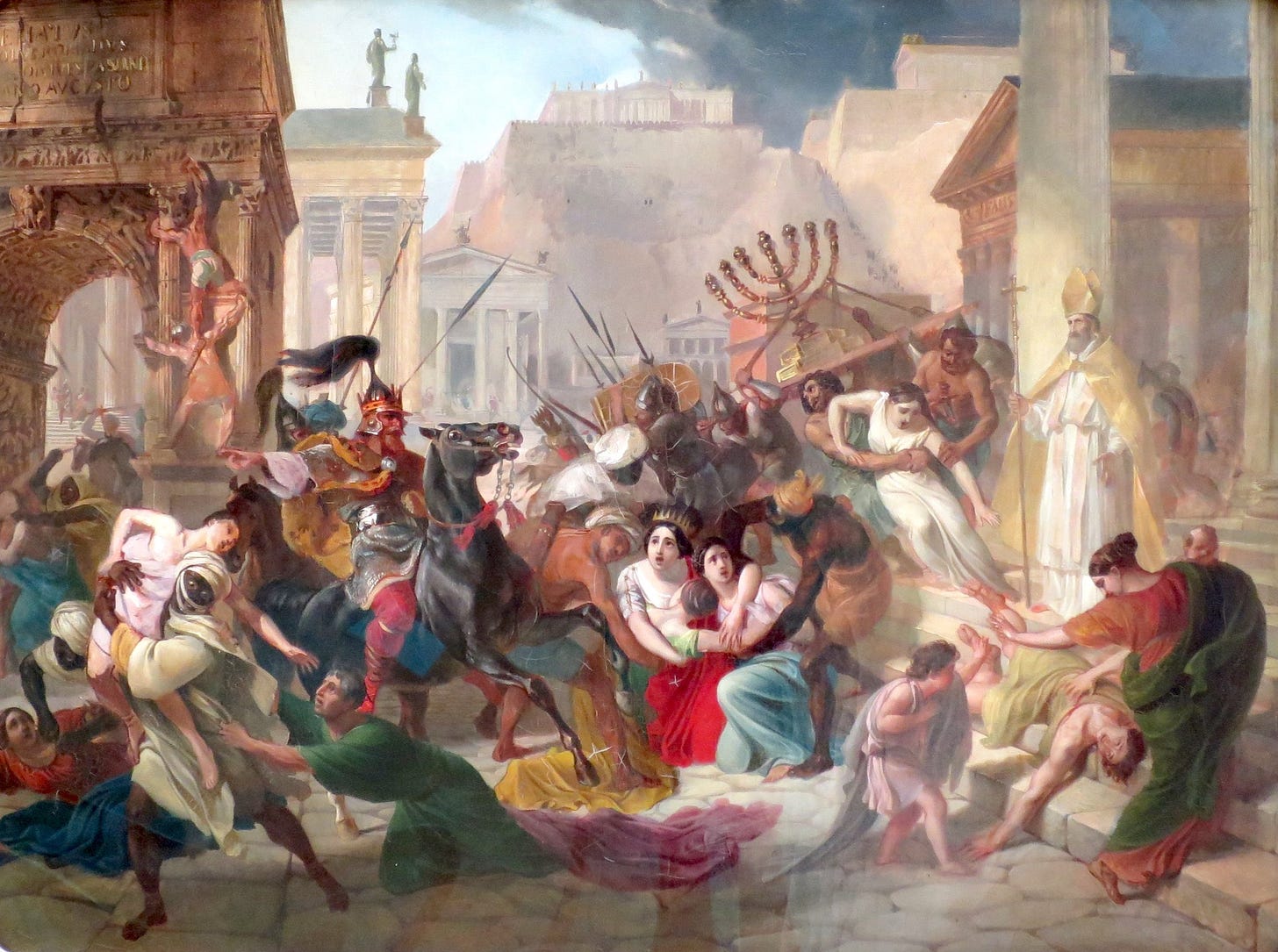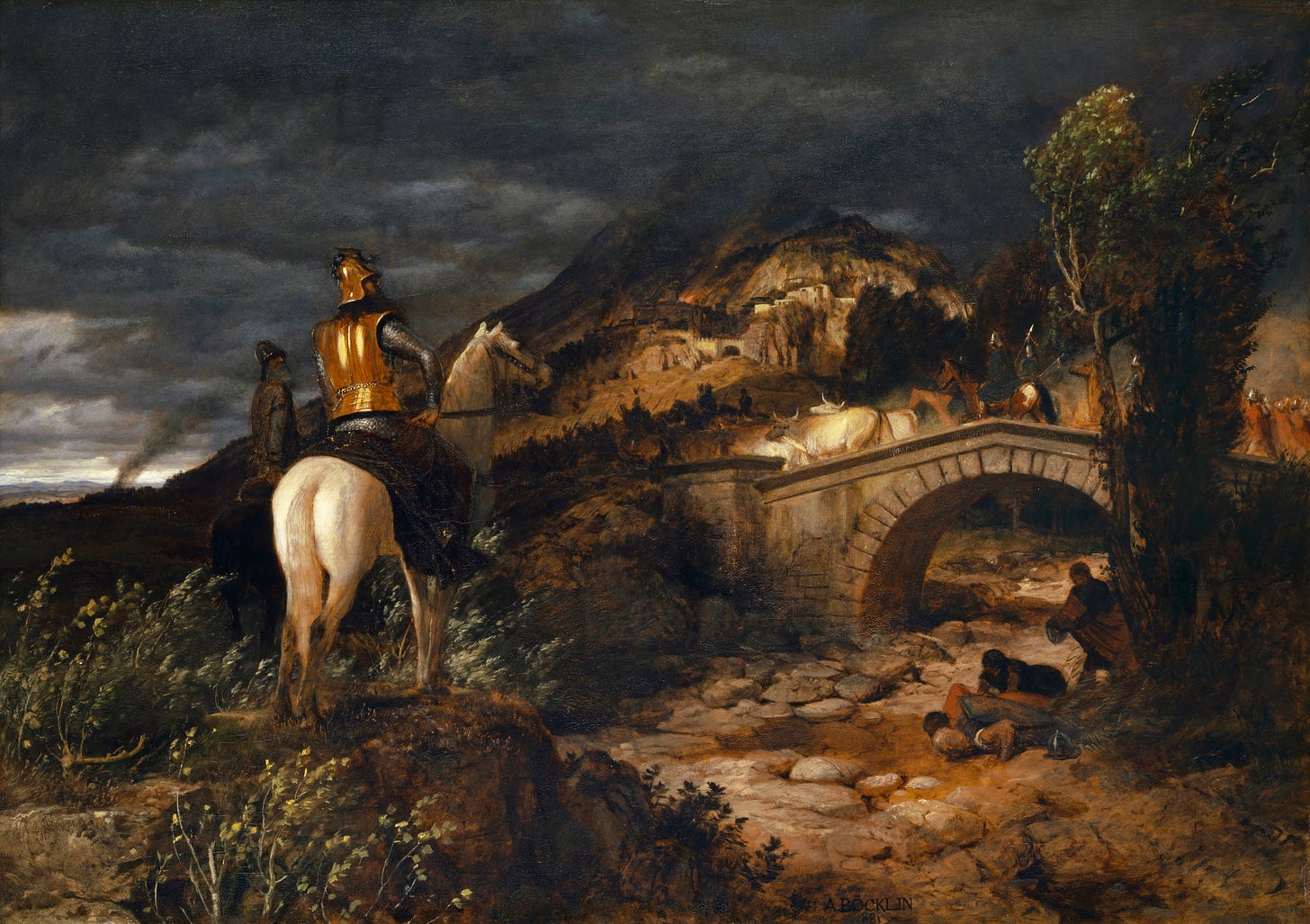How the Goths changed the fate of Europe
A guide to Gothic language and history
Rome, August 24th, AD 410.
For three days, the unthinkable has been happening. Soldiers — tall, fair-haired barbarians speaking a guttural tongue1 — are methodically plundering Rome. Rome! Heart of the eternal empire!
Palaces are looted, fires flicker against ancient marble, and the terrified populace huddles in churches spared by the invaders. For the first time in nearly 800 years, since its walls were last breached by Gallic tribes, Rome has fallen to an enemy.
The leader of these invaders is Alaric, king of the Visigoths. But he never set out to destroy Rome. His relentless march on the city was the culmination of years of frustration, broken promises, and a desperate need to find security for his people within the Roman world.
Alaric’s Visigoths had been shaped by their dealings with Rome, the empire whose spiritual capital2 they now occupied: sometimes allies, sometimes enemies. The sack of Rome meant more than a military victory for one Germanic tribe — it was a symbol of a world that was on the verge of a new age, and it sent shockwaves across the Empire, from Britain to Jerusalem.
Perhaps Rome was not eternal after all.
The sack of Rome also announced the arrival of the Goths as major players on the stage of history. But who were these people, capable of bringing the mighty Roman Empire to its knees? Their precise origins are lost to us in the murk of history, but their language has been preserved, in shimmering silver ink no less — a language oddly similar to our own.
And they left us a great deal more than that, as we’ll soon see.
You're reading The Dead Language Society. I'm Colin Gorrie, linguist, ancient language teacher, and your guide through the history of the English language and its relatives.
Subscribe for a free issue every Wednesday, or upgrade to support my mission of bringing historical linguistics out of the ivory tower and receive two extra Saturday deep-dives (like this one) per month.
The Goths emerge
But let’s begin at the beginning. Our earliest glimpses of a people called something like “Goths” come in the first century AD from the Roman writers Tacitus and Pliny the Elder, who mention the Gutones or Gotones dwelling near the Baltic Sea, in the area of modern-day Poland.
The most famous origin story for the Goths was one told by the 6th-century historian Jordanes, who may have been of Gothic descent himself. In Jordanes’ story, the Goths sailed from the island of Scandza — that is, Scandinavia, which is a Latinization of a Germanic word meaning ‘Island of Scandia.’ (Throughout the ancient and medieval periods, it was thought that Scandinavia was an island, or a group of islands.)
Jordanes’ account links the Goths to other Germanic peoples: the Gutes of Gotland and the Geats of Sweden (most famous as Beowulf’s people in the Old English poem of the same name). The names Goth, Gute, and Geat all seem to be related, although it’s still not entirely clear exactly how or why. One theory is that these names come from a root meaning ‘to pour’ — perhaps referring to a river, or to the idea that these peoples ‘poured’ their seed, in the sense that they sired many children. If that’s true, the name Goth comes from the same root as the word god — originally, ‘something to which libations are poured.’
Jordanes describes how the Goths sailed from Scandinavia and landed in a place near the mouth of the Vistula River, in modern Poland — a place which he called Gothiscandza. This link between the Goths and Scandinavia lines up with archaeological findings: the Goths in Gothiscandza are associated with the Wielbark culture, the name archaeologists have given to the people who lived on the Baltic coast of modern Poland during the first few centuries AD.
The Wielbark culture both burned and buried their dead — the people who preceded them only burned their dead. And Wielbark burials often involved mounds and stone circles, a custom they shared with Scandinavian burials. And more evidence has come in from recent genetic studies, which suggest an influx of people with Scandinavian ties into this region during the early first millennium AD.
However, the Scandinavian origin of the Goths isn’t entirely settled. For one thing, Jordanes wrote centuries after the supposed events. And definitive archaeological proof of a single, large-scale migration event from Scandinavia is lacking. If movement out of Scandinavia did in fact occur, it may not have been a situation where one well-defined group moved all at once to a new place, but rather something more gradual, perhaps involving smaller groups or elite clans.
In fact, the very identity of “Goth” seems to have evolved over time, in a process called ethnogenesis — the formation of an ethnic group. Early groups like the Gutones gave way to groups called Tervingi and Greuthungi, and finally, the two major divisions of Visigoth and Ostrogoth — Good Goths and East Goths — emerged. More on all of these shortly. But keep in mind that these groups likely reflected political confederations rather than monolithic ethnic blocs. Their identity was forged through shared experiences, migration, and, crucially, interaction with Rome.
Regardless of where exactly the Goths came from, we can trace their movement using archaeological evidence: they went from north to south. From the 2nd century AD onwards, the Wielbark culture expanded from the Baltic coast down the Vistula and Bug river valleys, into the southeastern part of modern Poland. This matches up with the appearance of the Goths north of the Black Sea from the 2nd–5th centuries AD, where they mingled with other peoples — the archaeologists call this mix the Chernyakhov culture.
The Chernyakhov culture shared traits with the Wielbark culture, traits such as its burial practices (a mix of burning and burial, without weapons in graves) and specific styles of brooches and pottery. This archaeological sequence of Wielbark into Chernyakhov paints a picture of a people moving from north to south, where they would soon get more involved with world affairs.
By the 3rd and 4th centuries, two major groups had become prominent: the Tervingi, who lived west of the Dniester River, and the Greuthungi, who lived to the east. The split between the two was deepened by the arrival of the Huns from the east around AD 370. Many Tervingi sought refuge from the Huns across the Danube in the Roman Empire in AD 376.
But the Romans weren’t always gracious hosts. In fact, Tervingi Goths were treated so poorly by Roman officials that they revolted — and utterly defeated the Romans in the Battle of Adrianople in AD 378, where the Roman Emperor Valens himself was killed. This battle was a turning point: it exposed Roman military vulnerability and led to a treaty in AD 382. This treaty settled the Tervingi Goths within the empire as foederati, that is, as an allied people ruled by their own leaders. It was this group who became known as Visigoths, and who, led by Alaric, eventually sacked Rome in AD 410 after years of broken Roman promises.
Meanwhile, many of the Greuthungi (aka the Ostrogoths) fell under Hunnic domination. After the collapse of Attila's empire around AD 454, they regained independence, settled in Pannonia (modern Hungary), and eventually, under Theodoric the Great, were commissioned by the Eastern Roman Emperor Zeno to invade Italy. In AD 493, Theodoric defeated the man ruling Italy at the time — a general named Odoacer, who was perhaps a Goth himself — to establish the Ostrogothic Kingdom in Italy, which had its capital at Ravenna.
Although Theodoric built his kingdom in Italy, the Goths carried with them something even more lasting than political power: the Gothic language. It's a language that has largely vanished from history, yet traces of it remain — and nowhere more so than in Spain, of all places....




